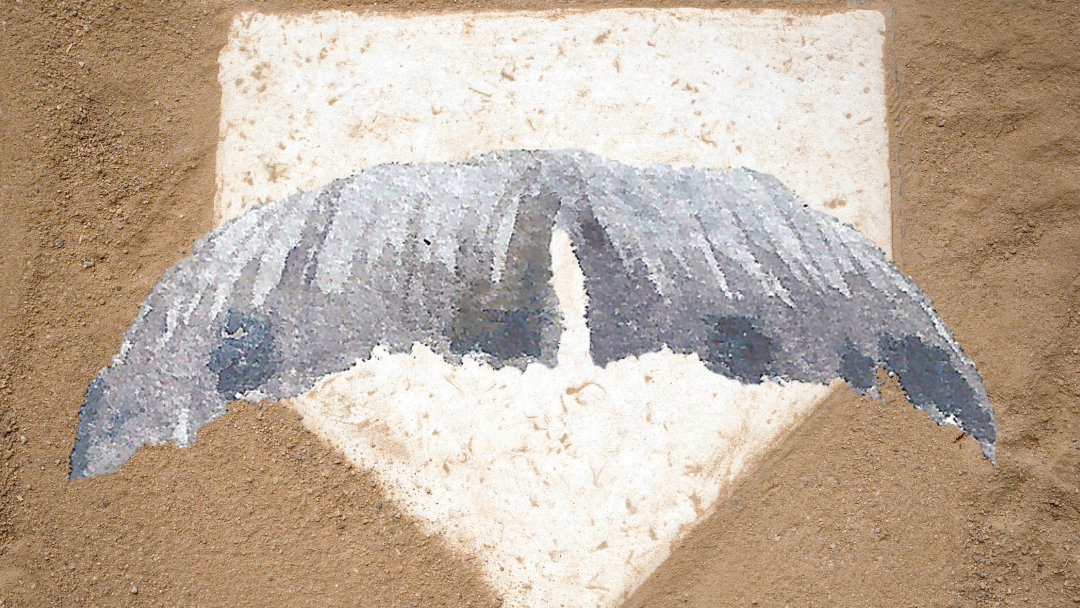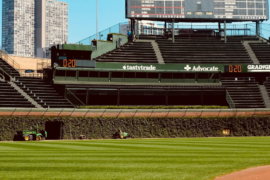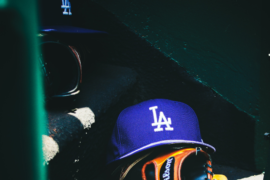I wanted to be Don Mattingly. A power-hitting first baseman with a Mario moustache and greasy slabs of eye black streaked across his cheekbone, he was the type of man who would chase a foul ball all the way to the edge of the field of play then dip his hand into the popcorn of an oblivious kid in the first row. The stupid look on that kid’s face when he caught Mattingly’s hand deep in the popcorn bag captured how I imagined everyone—kids like me, grizzled fans who call in to radio shows with anachronistic rants about how no one knows how to squeeze bunt anymore, even his cross-town rival Keith Hernandez—looked at the Yankees captain. His career began the year I was born, and, in just a handful of prodigious seasons, he had become arguably the best player in baseball. From ’84 -’89, he won five Gold Gloves and three Silver Sluggers, the batting title in ’84. He clinched the MVP in ’85 and came second in voting the next year. In ’87, he hit six grand slams and tied the record for most consecutive games with a homerun. Don Mattingly was so good his sport became part of his nickname: Donnie Baseball.
I stacked Mattingly baseball cards, plastered posters on my bedroom wall, and positioned a Don Mattingly Starting Lineup figurine prominently on my shelf. This idol worshipping part was easy, the personal changes not so much. I tried to bat lefty, but my brain couldn’t coordinate my body, and my herky-jerky southpaw swing was too embarrassing to even practice in front of a mirror. My parents refused to let me wear eye black, and I couldn’t grow a bushy mustache, so I dedicated myself to becoming a Gold Glove winner like him. Every night until it got dark, I’d peg a scuffed-up baseball at the two broken cement steps in front of my house and stab my mitt at erratic bounce backs. I was progressing well until I took a short hop to the eye at baseball practice. I wasn’t cut out to be an infielder. Nevertheless, my fandom was undeterred. The best player was on my favorite team, so he became my favorite. Or my favorite player happened to be on a team that then became my favorite. Either way, Yankees were life.
They were also horrible for my whole childhood. The Yankee Way is a metonym for sports success, yet, in the 80s and early 90s, the Yankees—owners of twenty-plus World Series trophies and a Monument Park in the outfield festooned with busts of former Bronx Bombers like Ruth, Gehrig, DiMaggio, Mantle (legends who need only one name)—sucked so badly. I have no memories of season-ending disasters or heart-breaking playoff losses, just highlights of rain delay broadcasts when the seven-time World Series winner Phil Rizzuto hid in the announcer’s booth because he was scared of lightning. Winning was absent, leaving a gap filled by a nostalgia for a past I hadn’t experienced. It was one thing to know the stories, but another to live them. I hungered for moments that broadcasters would talk about decades later. Each three-plus-hour game of the 162-game schedule was critical. On weekend afternoons, I sprawled out on the couch to catch the Pinstripes on WPIX. On weeknights, I’d listen in my top bunk until I fell asleep, with the radio at my ear to hear familiar voices and find company in misery and aspiration. In the morning, I’d pore over the box score in the Star Ledger sports section to track Mattingly’s progress. Amid all that losing, Mattingly did the right thing: he kept grinding. I had a reliable hero, albeit the protagonist of a story that kept disappointing.
Irascible Yankees owner George Steinbrenner, AKA The Boss, threw money at stars who weren’t really stars to recapture the volatile magic of the The Bronx Zoo era of the late 70s, when the Yankees last had won a World Series. He built the highest payroll of any team in the 80s, but even Steinbrenner had to know that signing the aging Pascual Perez, Jessie Barfield, and Steve Balboni was no recipe for success. These borderline stars teetered at the edge of their primes, likely seeking a final contract before their careers petered out. Yet, as a farm system product and lifelong Yankee, Mattingly was a loyal soldier. In a New York Times article critical of Steinbrenner’s spendthrift ways, Mattingly had his back: “…our organization is trying to win. It gets out of whack a little or something happens, but in my heart, I know we’re trying. We’ll do some things…You can’t get everybody. At least I know George is making the effort to get somebody… To me, that’s encouraging.” Clearly, having faith was my only option.
So, when Steinbrenner received a lifetime ban in 1990 (rescinded a few years later) after paying a “Bronx lowlife” to dig up dirt on his own player Dave Winfield (Winfield had sued The Boss for reneging on a contract stipulation to donate to the David Winfield Foundation for Children), I was excited. Change was good, and we still had Mattingly, which mattered immensely, even though injuries cost him sixty games in the ’90 campaign. He was the mulleted captain and heart of the team. As Mattingly’s body betrayed him, the farm system churned out hope. I collected the over-produced, junk wax era cards for hyped prospects like Hensley “Bam Bam” Meulens, Oscar Ozocar, and the #1 draft pick Brien Taylor. Now, those cards are barely worth the paper they’re printed on (though I’m sure they’re priceless for the players who achieved, for a short time, their childhood dreams). Players like Kevin Maas, ordained as the next Mantle after going on an unprecedented homerun tear, became the first Kevin Maas: a metaphor for those who crash and burn after flying too high, an Icarus in pinstripes. My childhood fandom was characterized by futility, so, equipped with old timer’s tales and fueled by blind passion, I flaunted my Yankees Starter jacket on the playground and argued about how much worse the Mets suck. Then the Yankees became the Yankees again.
In ’95, four prospects (Rivera, Jeter, Pettite, and Posada), later named the Core Four, launched a new dynasty. Steinbrenner’s absence from day-to-day operations had reinvigorated the Yankees, thanks to the patience of GM Gene Michael, who let prospects be prospects and avoided tossing money at problems money couldn’t fix. The Yankees had been cruising in ’94 and appeared a lock—for the first time in Mattingly’s thirteen seasons—to make the playoffs. Destiny had other plans. A players strike cut the season short and canceled the postseason, marking the first time in nearly a hundred years that the World Series wasn’t played. The Yankees came back stronger in ’95. Young teams need leadership, and this squad was led by the warworn veteran Mattingly, with his battle scars and steadfast faith (besides a slip-up in the spring of ‘91 when he inquired about a trade after being asked to shed his mullet). Unfortunately, though, the return to the Yankee Way coincided with the end of Mattingly’s career. Once feared for his power, Mattingly had become a slap hitter. Yet, he managed to summon one final spurt of awesomeness. In ‘95, when he reached the playoffs for only time, he transformed into the old Mattingly and tore the cover off the ball (.417 avg, 10 hits, 1 homerun, 6 RBIs, and 3 runs scored in five games). The Yankees still lost the series. He ended up taking off the ‘96 season to recover from injuries as if that final push sapped a finite resource. I’m not sure if his act was heroic—he wanted to win as much as anyone—but in the end, he sacrificed himself, whether for team or personal glory. The next year, as Mattingly convalesced, the Yanks won the ’96 World Series propelled by the Core Four, and, ultimately, this young team won four World Series in five years—the best run since the 50s. Mattingly never played another game.
Donnie Baseball, on a clear Cooperstown trajectory, whose body broke down before he could compile hall-of-fame stats, never relished in a championship with America’s winningest sports franchise. He had joined the Yankees a year after their 1981 World Series appearance and retired the year before the team won (’96), again (’98), and again (’99), and again (’00). The man did everything right, year after year, and everything went wrong. That was a profound lesson, and oddly similar to stories I knew from Hebrew school. Mattingly was the Job-like protagonist of my Yankees story. A season of TV has a full arc that’s resolved at the end, but the best shows get you hooked—see what happens next season! In sports, even when everything works out and you win the championship, it’s all about running it back next season. When you lose, whether in heartbreaking fashion or because you’re pathetic, there’s always next season.
Now, during the second longest World Series drought in Yankees history, I’ll nod along to podcast rants about how The Boss would have emptied the bank for Ohtani, or how current owner, his son Hal Steinbrenner, overpaid for Soto yet should have outbid the Dodgers for Yamamoto—and fast forward old timers’ complaints about how no one knows how to bunt anymore, wondering if I am now an old-timer. This generation idolizes Aaron Judge, a 6’ 7” home run machine who bested Maris’s hallowed—and steroid-free—American League homerun record (the real record). Judge has produced some of the most impressive offensive seasons ever, between seasons interrupted by freak injuries and a worldwide pandemic. I wonder if he’ll get his ring. “There’s a lot of stuff we gotta work on and improve, but there’s a lot of bright spots that we’ve seen with these young guys coming up. This is the time to build on that and start building that next foundation,” Judge said after a disappointing ‘23 season when the Yankees didn’t even make the postseason. Maybe ten-time World Series winner Yogi Berra was right to declare that “the future ain’t what it used to be.” Though, maybe it’s “deja vu all over again.” With my five-month-old on my lap, I wonder if Judge is his Mattingly, if my son will know that rare desire, the chase that culminates in a fleeting high, which in the best-case scenario—a championship—only results in another chase. Maybe he will be as intimate as I am with emotionally debilitating lows of sports—as a fan of the Jets (no Super Bowl since ’63); New Jersey Nets (no longer in existence); and Rutgers (a football team so bad when I was a freshman that free tickets were included with dining hall swipes). I push the thoughts aside and continue browsing the Yankees online store to find an Aaron Judge shirt in size 6-9 months.
JONATHAN HOROWITZ is an educator, muralist, and writer from Central Jersey. Currently, he develops policy and programming interventions to address health equity in communities experiencing poverty, while teaching creative writing to middle-schoolers on Long Island. He graduated with an MFA and massive student loan debt from Columbia University.
Like what you’re reading?
Get new stories, sports musings, or book reviews sent to your inbox. Drop your email below to start >>>
NEW book release
Direct Connection by Laura Farmer. Order the book of stories of which Mike Meginnis says there is “an admirable simplicity at their heart: an absolute, unwavering confidence in the necessity of loving other people.”
GET THE BOOK



